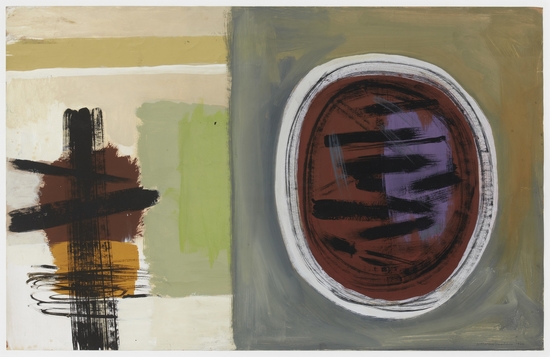Through the 1950s Wilhelmina Barns-Graham developed an abstract language that was derived from close observation of the landscape, but which increasingly emphasised geometric forms. In the early 1960s and for over 20 years through her mid-career, she turned away from landscape and based much of her art on arrangements of squares or circles (rarely both at same time). This Curation looks at the development and variety of 'uses' she put these basic geometric forms to during this period.
Wilhelmina Barns-Graham visited Spain and the Balearic Islands in 1958 which led to three distinct bodies of work; representational landscape works on paper made on location, gestural abstract paintings that take their cue from colours found in the Spanish landscape and the extended Spanish Island series, an example of which is seen here. Although the circle is anything but geometric and the brushwork is loose and expressive, the circle's presence along with the distinct vertical division of the canvas and lack of obvious direct connection to landscape are new elements in Barns-Graham's work.
Wilhelmina Barns-Graham (1912–2004)
Gouache on paper
H 57.9 x W 90.5 cm
Wilhelmina Barns-Graham Trust
1961
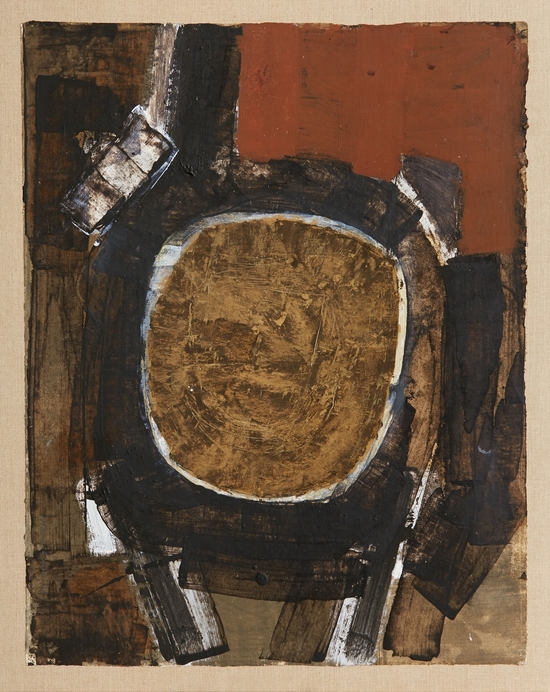
Barns-Graham spent most of her professional life based in the Cornish fishing village of St Ives, with from the mid-1960s several months a year also spent in Fife near the coast at St Andrews. However, for around 18 months in the early 1960s she lived predominantly in London where she rented a room and studio space from the Tate Gallery curator, Ronald Alley. The works she produced there are characterised by the use of dark, murky purples and blues, rusty reds and as seen here muddy browns. The use of Thames in the title certainly fixes the work to a geographical location, though perhaps not indicating any direct inspiration. Although still ungeometric in form, compared to the Spanish Islands works, the circle has become a central motif.
Wilhelmina Barns-Graham (1912–2004)
Gouache on paper
H 42.4 x W 54.5 cm
Wilhelmina Barns-Graham Trust
1962
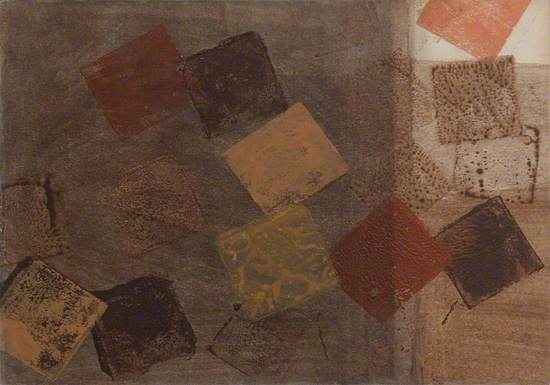
This early use of a standard size and shaped square employs Barns-Graham's 'London' palette. The work's use of a block of wood or similar to almost stamp the shapes across the picture surface still feels quite experimental at this stage, however Barns-Graham would develop and refine the basic elements and method of this work considerably over the following years. The proportional division of the picture surface is another formal element to which she would regularly return.
Wilhelmina Barns-Graham (1912–2004)
Cryla acrylic on board
H 17.9 x W 24.4 cm
Aberdeen Art Gallery & Museums
1963
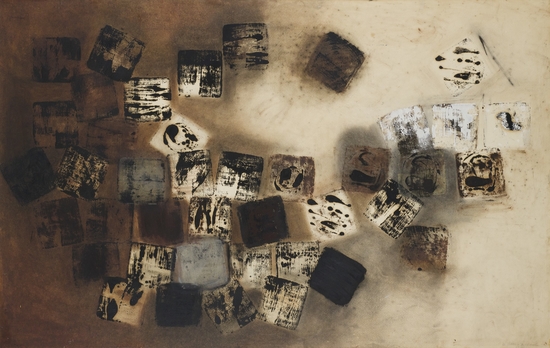
Cork on Sand is a significantly more refined and sophisticated development from Time Present and Different; the evenly sized squares are individually hand-coloured and there is a complexity to the composition that emphasises both movement and depth. This quality of depth to the picture is particularly accentuated by Barns-Graham's subtle use of browns and monochromes against a softer background.
Wilhelmina Barns-Graham (1912–2004)
Oil on hardboard
H 58.2 x W 91.1 cm
Wilhelmina Barns-Graham Trust
1964
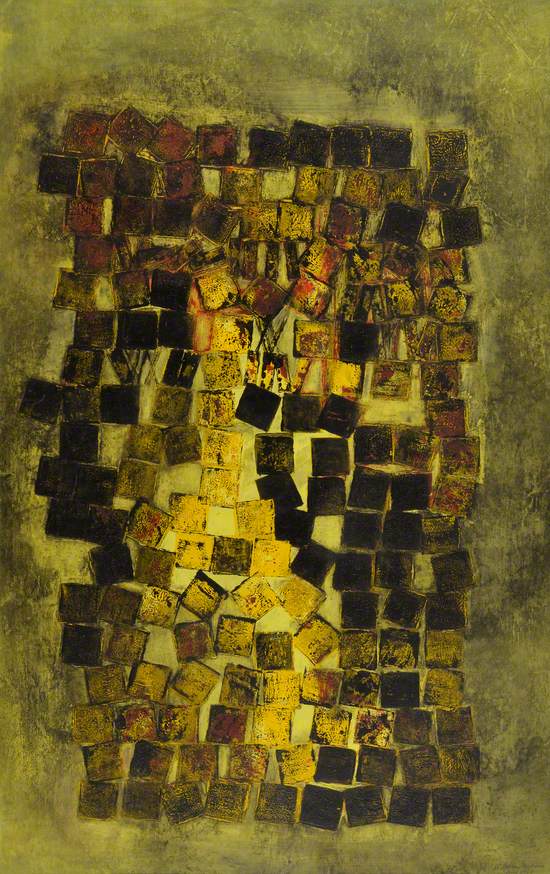
Assembly of Nine is one of a small group of works, also including Cinders (using red) and Dance of the Thermals (blue) that introduced both rich colouration, with a distinctive 'glow' and an increased number of densely packed squares to the compositions. Barns-Graham would come to refer to this extended series of works using squares dispersed across the picture plane as Things of a Kind in Order and Disorder. The titling of this work refers to both the number of squares per row, and an article of the Baha'i faith that requires 9 to be present to constitute a devotional assembly.
Wilhelmina Barns-Graham (1912–2004)
Oil on hardboard
H 90.5 x W 57.4 cm
Wilhelmina Barns-Graham Trust
1964
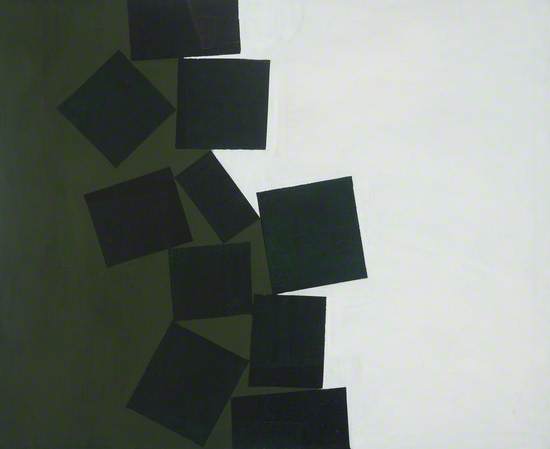
As Assembly of Nine was subtle in its use of colour and complex in composition, so Bottle Green, White and Black is bold and simple. The tumbling, irregularly sized squares and rectangles divide the two colours of the canvas with the sense of movement and tension of a collapsing tower.
Wilhelmina Barns-Graham (1912–2004)
Oil on canvas
H 112 x W 137 cm
Wilhelmina Barns-Graham Trust
1966
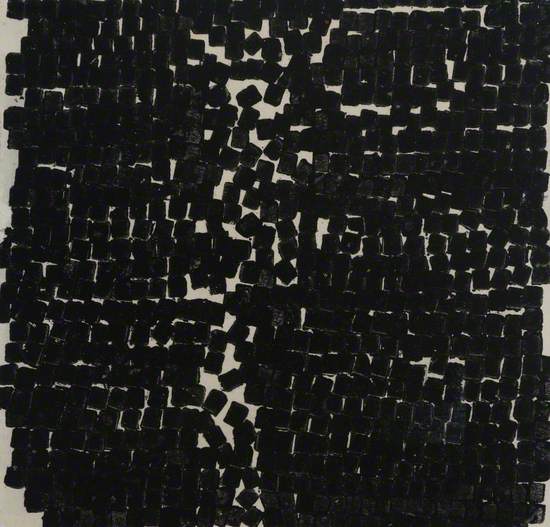
As well as larger finished works, like those previously seen, during this period Barns-Graham also produced large numbers of small works which further developed her ideas around movement and the possibilities of depicting the relationship between varyingly sized groups of a simple form. In contrast to Bottle Green, White and Black here the squares are numerous and form a densely packed, tight grid with only small disruptions and eddies allowing the lighter background to be seen through the gaps. Only in the central section does Barns-Graham return to a sense of falling and imminent collapse.
Wilhelmina Barns-Graham (1912–2004)
Acrylic on paper
H 15.2 x W 15.7 cm
Wilhelmina Barns-Graham Trust
1966
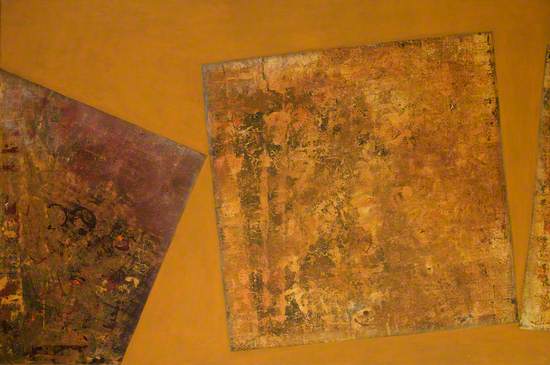
From the same year but in marked contrast to Meditation Series (Assemblage), Yellow Painting utilises monumentally scaled squares, indeed only one whole shape fits on the canvas, with a focus on the tension created by their points of contact. The rich, encrusted impasto of the surface of the squares contrasts sharply with the smoother paint of the background, emphasising the sense of the squares as objects moving through space.
Wilhelmina Barns-Graham (1912–2004)
Oil on canvas
H 105 x W 152 cm
Wilhelmina Barns-Graham Trust
1967

Pilgrimage is a particularly good example of a sub-group of the extended Things of a Kind series that seem to relate particularly to Barns-Graham's description of how the series originally developed. She described rows of card squares placed on the floor and then disturbed with her foot, the resulting 'disorder' would form the basis of her thinking for the entire series.
Within any particular series of related works Barns-Graham might title some using formal descriptions of the shapes and colours, while others might have much more specific or personal titles. Pilgrimage clearly falls in to the latter category and relates to her recent experience of making an annual journey to Norfolk to the Shrine of Our Lady of Walsingham.
Wilhelmina Barns-Graham (1912–2004)
Oil on canvas
H 101 x W 152 cm
Wilhelmina Barns-Graham Trust
1967
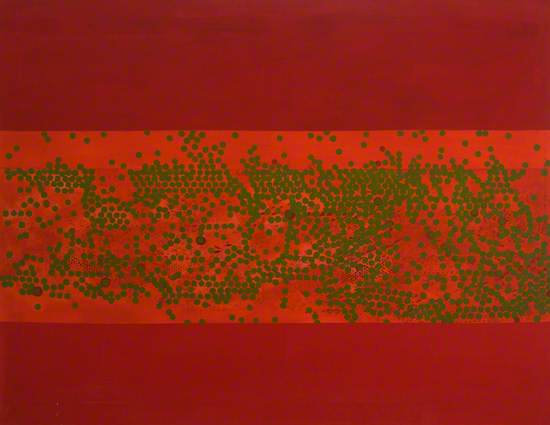
Olive Circles on Red is one of the earliest introductions of small circles (as compared the single monolithic circular motifs of the early 60s) by Barns-Graham. While many works of the period use clearly deliniated squares, here the circles seem to run into each other and swarm in masses irregularly dispersed across the canvas. As the title perhaps suggests, colour relationships and their optical impact are as important here as the those between the forms.
Wilhelmina Barns-Graham (1912–2004)
Oil on canvas
H 78 x W 100.5 cm
Wilhelmina Barns-Graham Trust
1970
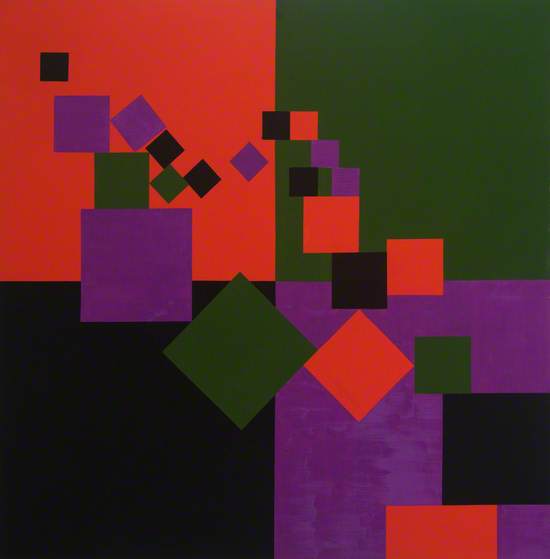
Returning to squares, Ascending Squares of Equal Amount is an example of a distinct group of works from 1969-70 in which Barns-Graham employed an increasingly considered, mathematical approach, here specifically utilising principles of proportion as the underlying method. Four colours are broken up into ascendingly sized squares over a simple quartered background, although spread across the canvas, there is an 'equal amount' of each colour. The few finished works in this series were the result of endless experimentation and calculation on sheets of graph paper.
Wilhelmina Barns-Graham (1912–2004)
Oil on canvas
H 122 x W 121 cm
Wilhelmina Barns-Graham Trust
1971
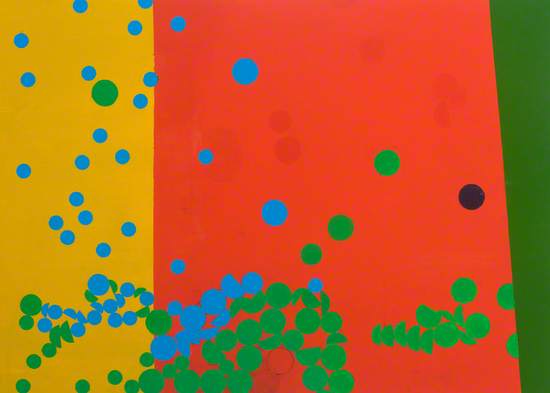
While the 1960s had been dominated by her use of squares, in the first half of the 1970s the circle was Barns-Graham's preferred shape. Here she uses the circles to both generate movement across the again vertically divided canvas and as a vehicle for dynamic colour. Like the earlier Olive Circles on Red, colour relationships are key to this work, leading to one of the most 'op' works in her oeuvre. When seen in the flesh the colour/shape juxtapositions lead to a distinct flashing optical effect.
Wilhelmina Barns-Graham (1912–2004)
Oil & acrylic on hardboard
H 58.5 x W 81.2 cm
Wilhelmina Barns-Graham Trust
1971
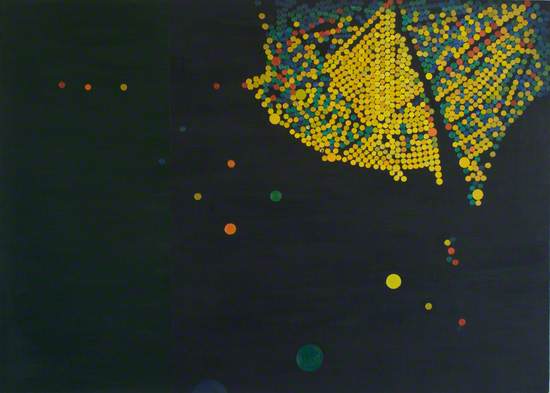
It is unclear at what point in its development Barns-Graham ascribed this particularly complex composition of small circles with the title Glasgow Airport. Like the earlier Pilgrimage its easy to see some aspect or quality of the title within the abstract arrangements of shapes and colours, though it is hard to be sure whether this was intended by Barns-Graham before she started work on the particular pieces or it occurred to her later in the process. Whichever, it is easy to read the painting as an abstraction based on the experience of seeing lights from an aeroplane at night.
Wilhelmina Barns-Graham (1912–2004)
Oil & acrylic on hardboard
H 58 x W 81.2 cm
Wilhelmina Barns-Graham Trust
1972
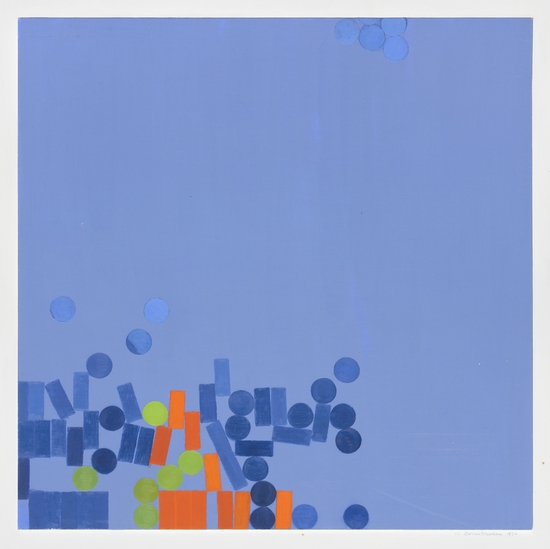
By 1972 Barns-Graham brought considerable confidence as well as occasionally a distinct playfulness and wit to the use of her favoured geometric forms. While her use of open expanses of colour on the picture surface increased at this time, Lime Green, Orange and Blue Mediterranean is unusual in its use of squares, circles and rectangles together in one picture. As usual the arrangements of shapes and colours and the relationships between them are engaging in themselves, however the very particular colours and the unusual hint given in the title help to bring this work into the world of experience, of sun, sea and light.
Wilhelmina Barns-Graham (1912–2004)
Oil on hardboard
H 50.6 x W 50.7 cm
Wilhelmina Barns-Graham Trust
1979

Barns-Graham returned to squares for a small group of works around 1978-79. Existing in 5-6 colour variants Warm Up, Cool Down is unique within the group being in a landscape rather than portrait format. While in all the earlier works discussed the squares or circles were, to varying degrees, irregularly distributed across the canvas to suggest movement, here the canvas is divided into a strict grid. Movement however is still generated across the canvas, but in Warm Up, Cool Down it is through the blues' subtle change from dark to light, using numerous slightly different shades, punctuated by pinks and oranges.
Wilhelmina Barns-Graham (1912–2004)
Acrylic on canvas
H 92.3 x W 123 cm
Wilhelmina Barns-Graham Trust
1980
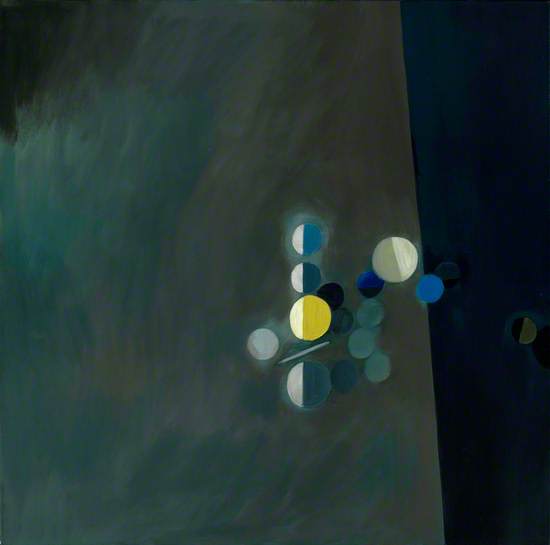
With the exception of perhaps Cork on Sand from 1963, the majority of works from this period are very flat, using the picture surface with little attempt to generate the illusion of depth. In the Day/Night series Barns-Graham still distributes circles across a divided canvas, however the softer edged, divided circles and particularly the use of white in the background all work to give the sense of the circles more as spheres existing within a 3-dimensional space, perhaps even celestial objects in Space.
Wilhelmina Barns-Graham (1912–2004)
Oil on canvas
H 101.5 x W 102.2 cm
Wilhelmina Barns-Graham Trust
